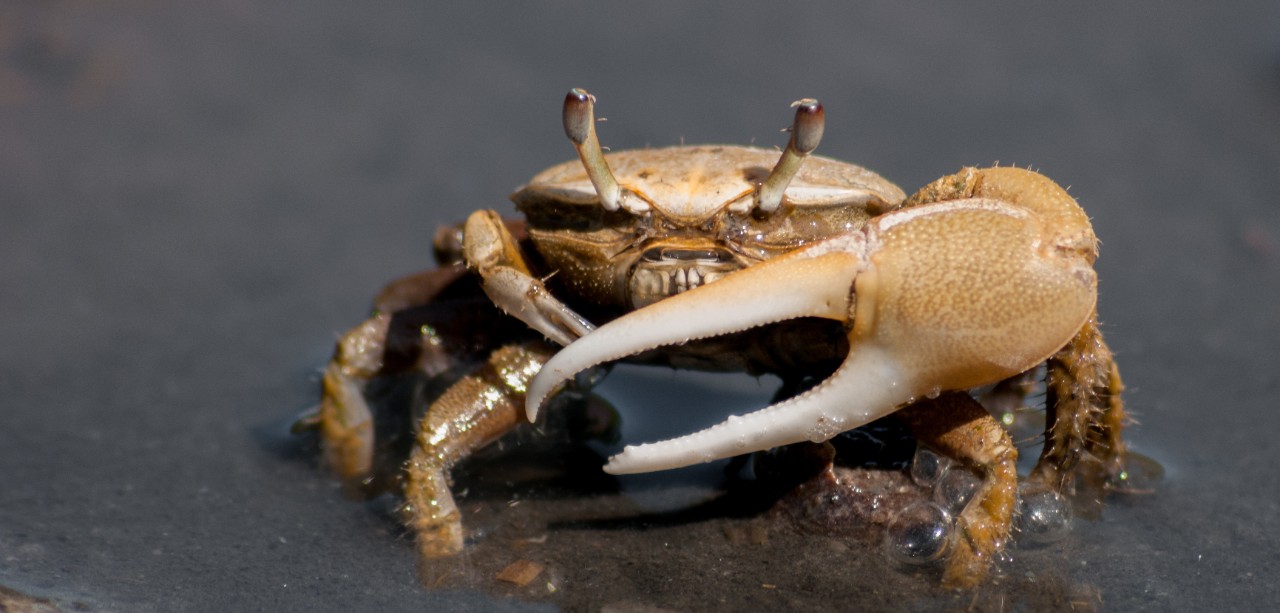
UC builds better test of animal vision
Biologists created a novel way to find out how well crabs and other creatures can discern color
Fiddler crabs have a simple solution to life’s daily perils: run.
University of Cincinnati biologists are using this compulsion to test the crabs’ color vision using simple modified electronics.
UC associate professor John Layne studies fiddler crabs, little saltwater crustaceans named for the way males wave one oversized claw as if playing a violin.
Scientists have long known that fiddler crabs have cells sensitive to UV and green light. And at least one species that Layne studies may also be sensitive to a third wavelength. In theory, this vision would be somewhat similar to ours (called trichromatic.) Most people can detect a huge variety of colors – more than 1 million. We can even tell when one shade is slightly different from another.
Layne wants to know if crabs can do likewise.
Layne and his students created a miniature movie theater that uses a stripped-down liquid crystal display like the kind found in many computer monitors. A crab is placed in a little glass arena under a tilted screen projecting a video illuminated in color by blue and green light-emitting diodes.
The project demonstrates UC's commitment to research as described in its strategic direction called Next Lives Here.
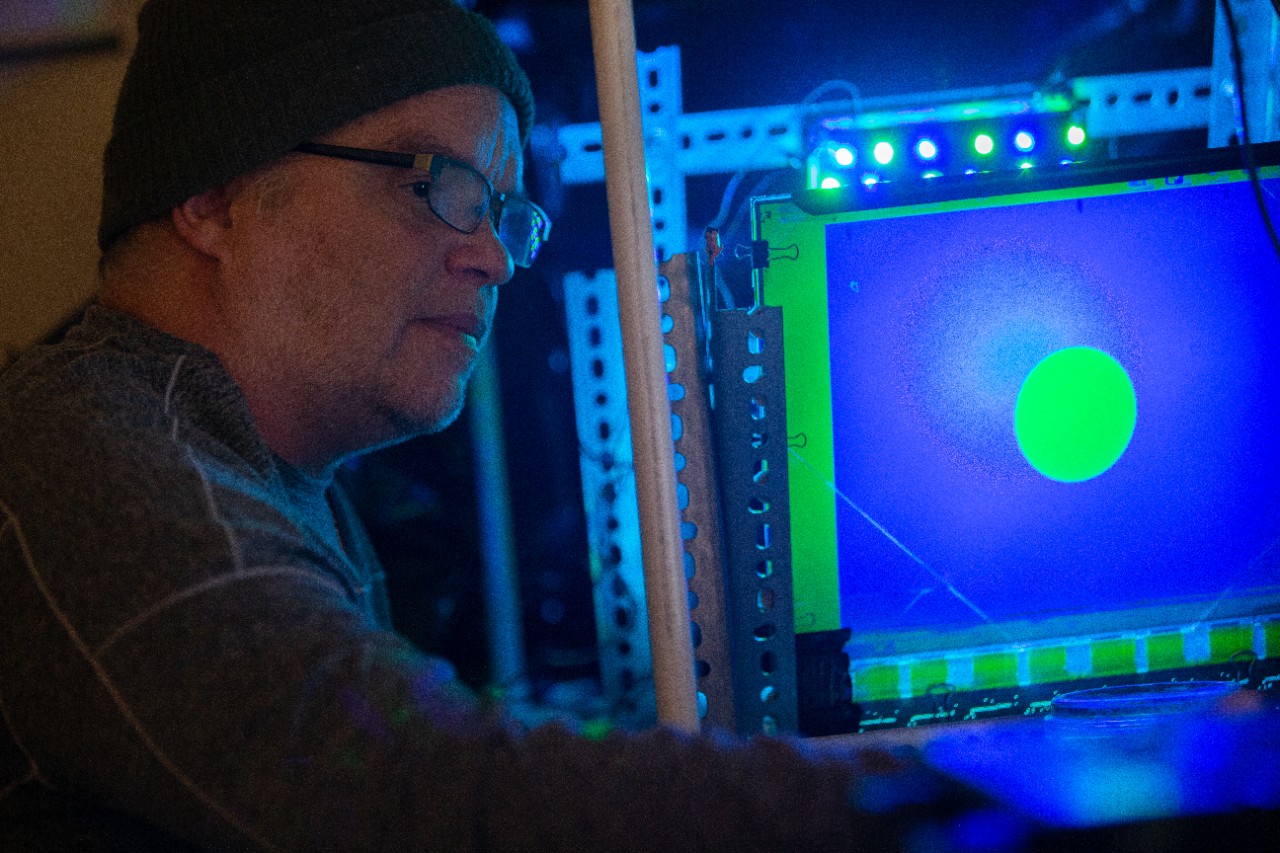
UC biologist John Layne and his students created a simple color vision test for fiddler crabs and other animals that uses a modified liquid crystal display. Photo/Andrew Higley/UC Creative Services
The video shows a looming stimulus — a round ball that appears to approach the crabs quickly on screen — like the famous boulder scene in “Raiders of the Lost Ark.”
And like Indiana Jones, the crabs always react in kind.
“They run like a bat out of hell. Their reaction is not subtle. They will sprint really fast and bang into the wall,” Layne said.
You never know where the next big contribution to science will come from.
Jeremiah Didion, UC graduate
The consistent reaction to the approaching virtual ball helps UC biologists measure the spectrum of visible light the crabs can see.
“We’re using it to test color discrimination. For an animal to have color vision, what that really means is the ability to discriminate different wavelengths of light,” Layne said. “They can see green light. They can see blue light. But can they tell the difference? That’s the test.”
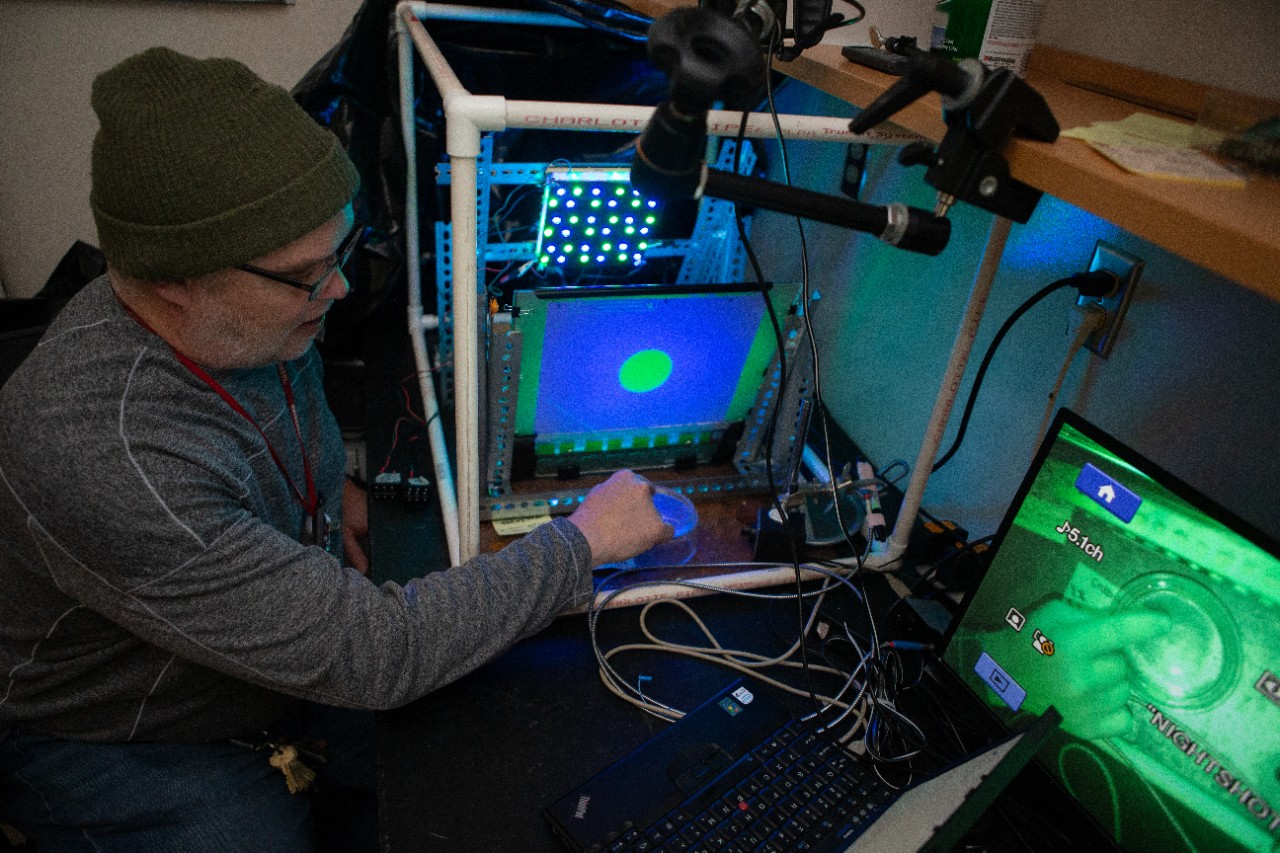
UC biologist John Layne developed a simple color vision test for crabs and other animals that uses a liquid crystal display and adjustable light-emitting diodes. The screen projects a fast-approaching object of one color set against a background of another color. The quick reaction of the crabs indicates they can see the colors in the optical illusion. Photo/Andrew Higley/UC Creative Services
Student research
Layne and student co-authors Jeremiah Didion and Karleigh Smith described their vision-testing device in the journal Methods in Ecology and Evolution.

UC graduate Jeremiah Didion holds up a ghost crab on a beach. He is unravelling the color vision of animals. Photo/Provided
Researchers have only begun to explore the complex visual abilities of animals. While we can see about 1 million colors, some spiders are believed to see 100 times that. And the reigning record holder? Scientists believe it’s the mantis shrimp, which has four times as many color receptors as we do.
“Just having these color cells doesn’t mean they use them for color vision like we do. They might just have these cells that cover more of the spectrum to capture more light,” Layne said. “That would be advantageous for animals that live in dim or dark conditions.”
Fiddler crabs usually have the opposite problem: too much light, Layne said. Their eyes sit on tall eyestalks that serve as periscopes to peer across the mudflats. Their eyes wrap around the tips of these eyestalks.
“Part of their eye is staring at the sun at all times. That is a problem for them,” Layne said.
They compensate with screening pigments that prevent their vision cells from getting fried by excessive solar radiation, he said.
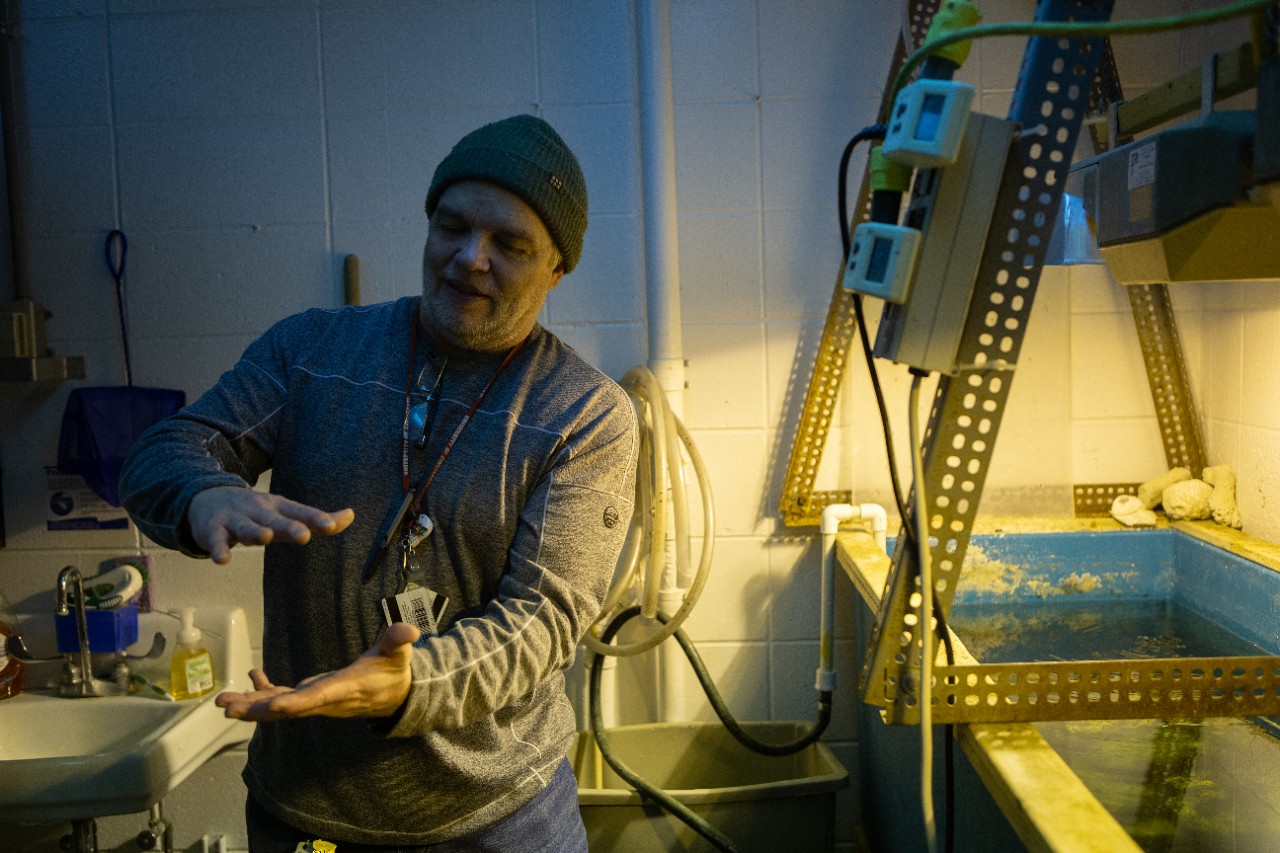
UC associate professor John Layne keeps fiddler crabs in twin saltwater tanks that mimc the tides in his biology lab. Every six hours and 20 minutes, one tank drains into the other to expose bare sand or rocks like the shoreline where fiddler crabs live. Photo/Andrew Higley/UC Creative Services
Happy home for crabs
Layne keeps his fiddler crabs in ingenious tanks that mimic the changing tides, draining from one tank to the other and back in slightly more than six-hour intervals. At “low tide,” the tank’s algae-covered rocks are exposed for the crabs. A second tank is full of deep sand so the crabs can dig burrows that periodically flood with rising tide.
The male crabs skitter sideways, holding their larger “fiddle” claw in front of them like a gladiator’s shield. Some are right-clawed; some left-clawed. It’s random. Females have two equally small front claws.
For their experiments, UC researchers assembled a panel full of bright green and blue LEDs. The green lights on the board seem to shine more brightly than the subdued blue ones. But Layne said it’s an optical illusion.

UC associate professor John Layne is a sensory neurobiologist whose National Science Foundation-funded work has explored animal vision and navigation. Photo/Andrew Higley/UC Creative Services
“The machine tells us the blue diodes are pumping out significantly more light than the green ones,” he said. “We only see it that way because we’re more sensitive to green. Objectively, the blue lights are far brighter.”
Another fun fact? Layne said your white computer screen isn’t actually white but a mix of tiny blue, green and red computer pixels that create the illusion of white.
The LEDs provide adjustable color to the “twisted nematic LCD” screen so that the normally black and white image is rendered in color. By increasing or decreasing the intensity of the light, they can test whether the crabs can differentiate light wavelengths represented as different hues of blue or green on the screen.
Didion, a UC doctoral graduate and the paper’s lead author, said the crabs don’t acknowledge the approaching object until it reaches a threshold that triggers a reaction.
“They don’t have very good spatial resolution compared to humans. But they have a very fast escape response,” Didion said.
Likewise, the crab typically has to be in the path of the approaching ball to trigger a response. The crabs are good at judging trajectory, Layne said.
“If the crab is off-center, he might not react at all because he can tell the approaching object is not going to hit him,” he said.
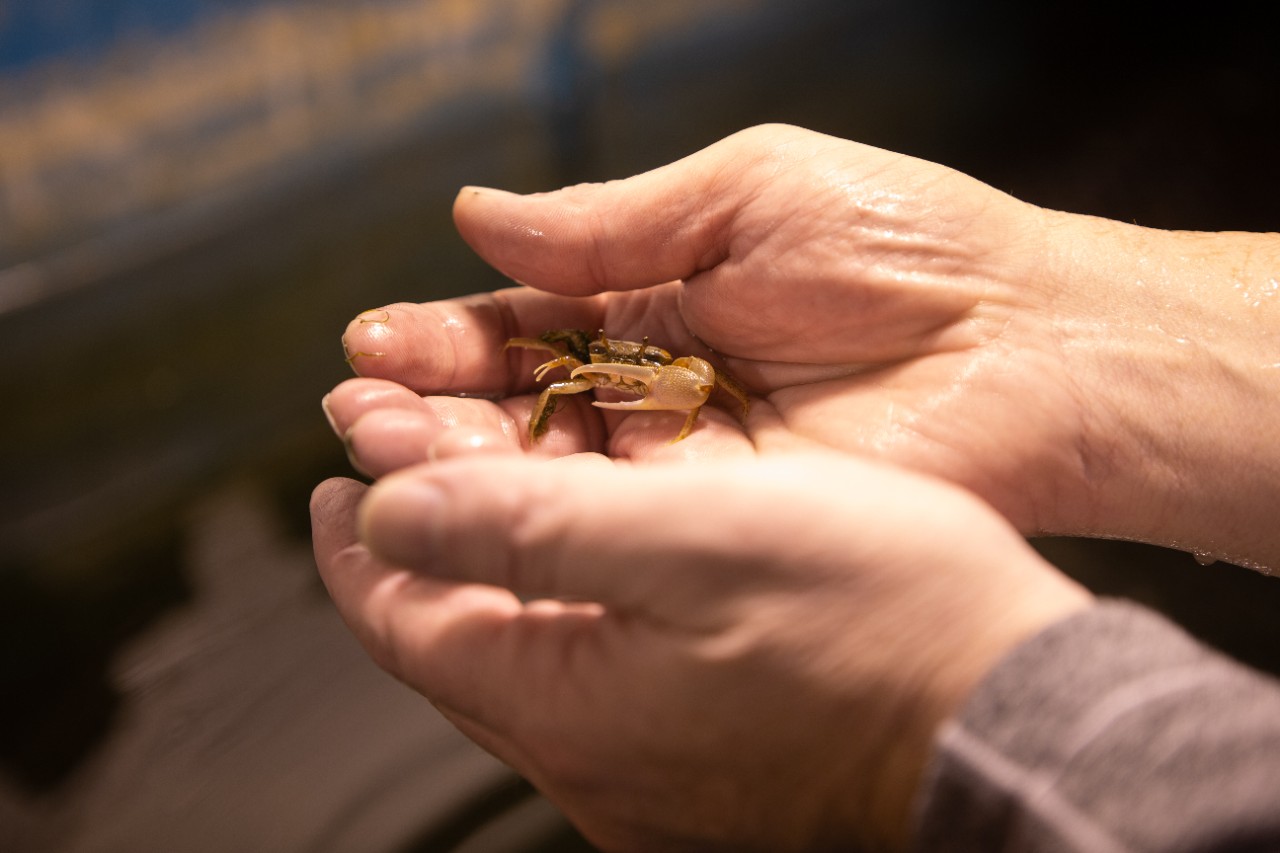
UC associate professor John Layne studies the navigation and vision of fiddler crabs in his biology lab. Photo/Andrew Higley/UC Creative Services
The crabs are especially sensitive to objects that appear higher in their field of vision, like predatory birds. They are far less concerned about objects that appear at eye level or lower, even if those objects might be predators as well, Layne said.
The crabs live in a flat world where anything shorter than the crab would pose little threat. Fiddler crabs make a nice snack for a myriad of coastal predators, from gulls to raccoons to other crabs.
Layne is one of several UC biologists who are unraveling the secrets of animal vision. Their discoveries can improve the understanding of our own vision deficits and diseases.
Didion is continuing his biology studies at Case Western Reserve University. He said insights we gain from animals can lead in surprising directions.
“The value of studying the animal kingdom is exploration. You feel like a modern-day explorer,” Didion said. “You never know where the next big contribution to science will come from.”
Featured image at top: UC is investigating how well fiddler crabs can distinguish colors. Photo/Wilfredor/Wikimedia Commons

UC associate professor John Layne uses his color discrimination device to illustrate connections between engineering and biology during outreach presentations to high school students. Photo/Andrew Higley/UC Creative Services
Next Lives Here
The University of Cincinnati is classified as a Research 1 institution by the Carnegie Commission and is ranked in the National Science Foundation's Top-35 public research universities. UC's graduate students and faculty investigate problems and innovate solutions with real-world impact. Next Lives Here.
Become a Bearcat
- Apply online or get more information about undergraduate enrollment by calling 513-556-1100.
- Learn more about UC's many undergraduate and graduate programs.
Related Stories
Two College Credit Plus high school students receive bachelor’s...
May 4, 2025
Two high school students received bachelor's degrees at the University of Cincinnati's Spring Commencement. Caden Elrod, a senior at Walnut Hills High School in Cincinnati, and Sai Gollamudi, a senior at Centerville High School in Centerville, receive their degrees while also completing their diplomas. They are first high school students in UC's College Credit Plus Program to earn bachelor's degrees.
UC celebrates record spring class of 2025
May 2, 2025
UC recognized a record spring class of 2025 at commencement at Fifth Third Arena.
UC students recognized for achievement in real-world learning
May 1, 2025
Three undergraduate University of Cincinnati Arts and Sciences students are honored for outstanding achievement in cooperative education at the close of the 2024-2025 school year.
